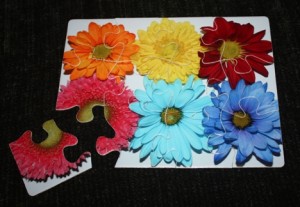Guest Article by Monica Heltemes, OTR
“That’s enough of this,” my client, Mary Ann, told me when we try to work on one of the 100-piece jigsaw puzzles that she has enjoyed doing for many years. Puzzles provide cognitive stimulation, and they are good for Mary Ann to keep active. However, her memory loss had progressed and her words did not tell me but her expressions and demeanor did – she was frustrated that she could no longer do the puzzle. She would rather sit quietly in a chair than submit herself to activities that blatantly showed how confused she was.
What does “doing things” mean to you? For some people, it means reading a book, golfing with friends, or setting a jigsaw puzzle. Activities such as these, that challenge the brain and promote social engagement, are contributors to brain health such as the National Brain Challenge and help define who we are.
What happens to people with Alzheimer’s disease or other forms of dementia, who experience memory loss, a decline in planning skills, and decreased initiation to do things? They often become inactive, potentially leading to pacing, sleeping, boredom, or restlessness.
 According to research published in the American Journal of Occupational Therapy in May 2009 the remaining cognitive, social, and emotional capabilities of persons with dementia living in Alzheimer’s units were rarely tapped. This can lead to the person experiencing “excess disability” or disability beyond what is directly attributable to the disease itself. A more rapid decline can ensue.
According to research published in the American Journal of Occupational Therapy in May 2009 the remaining cognitive, social, and emotional capabilities of persons with dementia living in Alzheimer’s units were rarely tapped. This can lead to the person experiencing “excess disability” or disability beyond what is directly attributable to the disease itself. A more rapid decline can ensue.
This is often true of persons living at home, as well, as caregivers struggle to keep up with the caregiving demands. According to a survey administered by the National Alliance for Caregiving, caregivers are looking for ideas for easy activities they can do with their loved one. Engaging the person with dementia in activity offers caregiver support and cognitive stimulation for the user. However, caregivers may not always know how incorporate activities into the day.
Here are 3 tips on how caregivers can help keep persons with dementia stay active. Remember the “3 R’s” of education – Reading, ‘Riting, and ‘Rithmetic? We’re replacing those 3 Rs with – Routine, Reduce, and Reassurance.
Routine
Persons with dementia do best with routine. To help bring some order to a confusing world of forgetfulness and disorientation, the person needs the same activities done in a typical order and timeline each day. What works best for you may not be what works best for him and her. Usually, going with their flow will make the day easier for both of you.
Reduce
Persons with dementia have short-circuits in the way their brain works. They need things to be reduced, so that they can work their way around these short-circuits–reducing elements of the task such as the number of steps; the directions given; and the level of abstractness.
Reassurance
The person with dementia may at times be reluctant to participate when you ask. This may be due to fear of failure. A more reassuring way is to ask for help. Offer reassurance throughout the activity and after – “You are doing great! Thanks for your help!”
Monica Heltemes is a registered occupational therapist and owner of MindStart® – Activities for Persons with Memory Loss. The vision of MindStart is a world where persons with dementia and their caregivers enjoy active and joyful days. Contact Monica Heltemes.
References
“Caregiving in the U.S.” National Alliance for Caregiving and AARP (April, 2004).
Wood, W., Womack, J., Hooper, B. “Dying of Boredom: An Exploratory Case Study of Time Use, Apparent Affect, and Routine Activity Situations on Two Alzheimer’s Special Care Units.” The American Journal of Occupational Therapy, 63 (3), 337-350 (2009)









